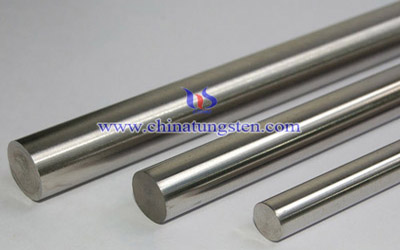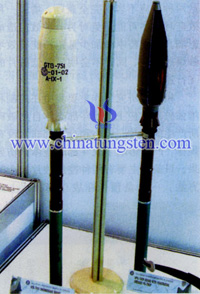Tungsten Alloy Swaging Rod Processing
- Details
- Category: Tungsten Information
- Published on Thursday, 01 August 2013 17:18
- Hits: 1956

Firstly, mix tungsten powder together with other elements, such as Ni, Fe, Cu, etc. Put them into a specially designed mold which is in heating furnace. Heat up to a certain temperature and through a certain time, we can get tungsten alloy rod.
Secondly, transfer the rod to a temporary support which supports the tungsten alloy rod is heated three quarters of an hour at about I600°C. In an electrically heated tube furnace, tungsten alloy rod is protected from oxidation at this temperature by hydrogen gas. Tungsten alloy rods are heated to about 1600°C. Then with an atmosphere of hydrogen gas in an electric furnace, tungsten alloy is rapidly passed through the swaging machine. In this operation the diameter of the rod is reduced 10 percent. Tungsten alloy rods are then re-heated in the furnace and are ready for the next pair of swaging dies which will again reduce its diameter by 10 percent.
Thirdly, machining. Tungsten alloy is so hard that it cannot be machined by sharp edge tools, but it can be brought into desire shapes by high temperature hammering or cold grinding.

Tungsten Manufacturer & Supplier: Chinatungsten Online - http://www.chinatungsten.com
Tel.: 86 592 5129696; Fax: 86 592 5129797
Email: sales@chinatungsten.com
Tungsten Picture Center: http://picture.chinatungsten.com
Tungsten Video Center: http://v.chinatungsten.com
Tungsten News & Tungsten Prices, 3G Version: http://3g.chinatungsten.com
Introduction of Tungsten Alloy Swaging Rod
- Details
- Category: Tungsten Information
- Published on Wednesday, 31 July 2013 09:40
- Hits: 1914

Tungsten alloy swaging rod is made of tungsten alloy rod through calcinations. The normal method used in the processing are extruding, forging and sintering. After calcinations, tungsten alloy swaging rod has higher ductility, toughness and tensile strength than tungsten alloy rod, so it can be used for a longer time. Tungsten alloy swaging rod is widely used in industry as well as military areas, such as rifle bullet, armor piercing, snipe rifle penetrator, etc.
Advantages of tungsten alloy swaging rod: low cost, easy operation, convenient processing adjustment and control, harder, more durable, excellent hardness (40HRC, tungsten alloy rod between 26HRC and 30HRC), high ultimate tensile strength (1200MPa~1400MPa), etc.

Tungsten Manufacturer & Supplier: Chinatungsten Online - http://www.chinatungsten.com
Tel.: 86 592 5129696; Fax: 86 592 5129797
Email: sales@chinatungsten.com
Tungsten Picture Center: http://picture.chinatungsten.com
Tungsten Video Center: http://v.chinatungsten.com
Tungsten News & Tungsten Prices, 3G Version: http://3g.chinatungsten.com
Tungsten Alloy Defenses
- Details
- Category: Tungsten Information
- Published on Tuesday, 30 July 2013 09:49
- Hits: 2013

Tungsten alloy defense technology in the area of thin-walled guided missiles allows bullets weighing 700 grams to hold 500 grams of effective load. The function of ejection stand off ammunition is to make a barrage out of the tungsten alloy defense, but not to markedly increase their kinetic energy. Nitrified fiber firing ammunition and a high intensity carbon steel ammunition cartridge endows the bullets with 1050metre/sec initial velocity.
Tungsten Military Application in Types of Weapons:
◆The GNU-44 Viper Strike missile, carried by armed drones, has a tungsten sleeve to produce powerful shrapnel.
◆The 130-round-per-second Phalanx anti-missile Gatling gun, deployed on U.S. and Royal Navy ships, originally used DU rounds. They were replaced with tungsten alloy, for environmental reasons.
◆120mm anti-tank rounds use tungsten military application as an alternative to DU in training. So do the 25mm anti-tank rounds, on board the M2/M3 Bradley fighting vehicle.
◆Armor-piercing .308 M993 rifle rounds.
◆The 120mm M1028 anti-personnel round, fired by the Abrams tank. It's basically a giant shotgun shell loaded with 1100 tungsten balls, each 3/8th of an inch big.
◆Dense Inert Metal Explosives, the "focused lethality" ammunition used by the U.S. and Israel. Tungsten military application contains micro-shrapnel made of tungsten powder.
◆Some 70mm rockets fired by Apache helicopters release tungsten military application flechette

Tungsten Manufacturer & Supplier: Chinatungsten Online - http://www.chinatungsten.com
Tel.: 86 592 5129696; Fax: 86 592 5129797
Email: sales@chinatungsten.com
Tungsten Picture Center: http://picture.chinatungsten.com
Tungsten Video Center: http://v.chinatungsten.com
Tungsten News & Tungsten Prices, 3G Version: http://3g.chinatungsten.com
Tungsten Alloy Military Properties
- Details
- Category: Tungsten Information
- Published on Wednesday, 31 July 2013 09:31
- Hits: 1926

Tungsten alloy military properties: high density (60% denser than lead and much denser than steel), high temperature resistance, high melting point, excellent hardness (40HRC, tungsten alloy rod between 26HRC and 30HRC), good corrosion resistance, superior wearing resistance, high ultimate tensile strength (1200MPa~1400MPa), non-toxic and environmentally friendly, etc. Apart form these tungsten alloy properties, tungsten alloy also has military properties. Tungsten military properties: high velocity, long hitting the distance and good accuracy, etc.
As for tungsten alloy military properties, it is the best material to make military weapon such as: bullet, armor piercing fin stabilized discarding sabot (APFSDS), flying carrier, armor and shells, shrapnel head, bulletproof vehicles, grenade, tanks panzers, cannons, firearms, etc. The product decide it uses in military field.

Tungsten Manufacturer & Supplier: Chinatungsten Online - http://www.chinatungsten.com
Tel.: 86 592 5129696; Fax: 86 592 5129797
Email: sales@chinatungsten.com
Tungsten Picture Center: http://picture.chinatungsten.com
Tungsten Video Center: http://v.chinatungsten.com
Tungsten News & Tungsten Prices, 3G Version: http://3g.chinatungsten.com
Corrosion Resistance of Tungsten Carbide
- Details
- Category: Tungsten Information
- Published on Monday, 29 July 2013 13:58
- Written by Yuri
- Hits: 2016
Cobalt is by far the most widely used binder metal or “cement” in cemented tungsten carbides because it most effectively wets tungsten carbide grains during liquid phase sintering. For this reason cobalt is believed to be superior to other binder metals in terms of eliminating residual porosity and achieving high strength and toughness values in sintered products. The failure of cemented carbides in corrosive environments, however, is generally due to the chemical reaction of cobalt with corrosive agents. The corrosion process involves the dissolution of the cobalt binder at exposed surfaces leaving a loosely knit skeleton of tungsten carbide grains having little structural integrity. This mechanism is often referred to as cobalt “leaching” and is typically accompanied by a flaking off of unsupported carbide grains in the affected surface areas.
Although WC + Co grades have fairly good resistance to attack by acetone, ethanol, gasoline and other organic solvents as well as by ammonia, most bases, weak acids, and tap water. Exposure to formic, hydrochloric, hydrofluoric, nitric, phosphoric, sulfuric, and other strong acids, however, can result in a relatively rapid deterioration of the binder phase. Corrosion rates are affected also by temperature, the concentration and electrical conductivity of the corrosive agent, and by other environmental factors. Alloying cobalt with chromium, molybdenum, and/or nickel can significantly improve the resistance of the binder to corrosion, but the complete substitution of nickel for cobalt has proven to be the most effective means of extending the life of cemented carbides in highly corrosive environments. WC + Ni grades and other special formulations designed to resist corrosion without compromising strength or other attributes are therefore ideal for applications such as seal rings, fluid control components, choke valves, nozzles, and bearings.
Tungsten Carbide Manufacturer & Supplier: Chinatungsten Online - http://www.tungsten-carbide.com.cn
Tel.: 86 592 5129696; Fax: 86 592 5129797
Email: sales@chinatungsten.com
Tungsten Picture Center: http://picture.chinatungsten.com
Tungsten Video Center: http://v.chinatungsten.com
Tungsten News & Tungsten Prices, 3G Version: http://3g.chinatungsten.com





 sales@chinatungsten.com
sales@chinatungsten.com